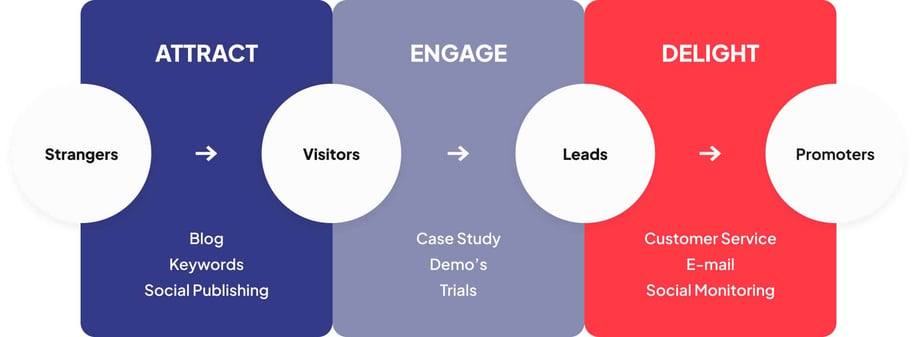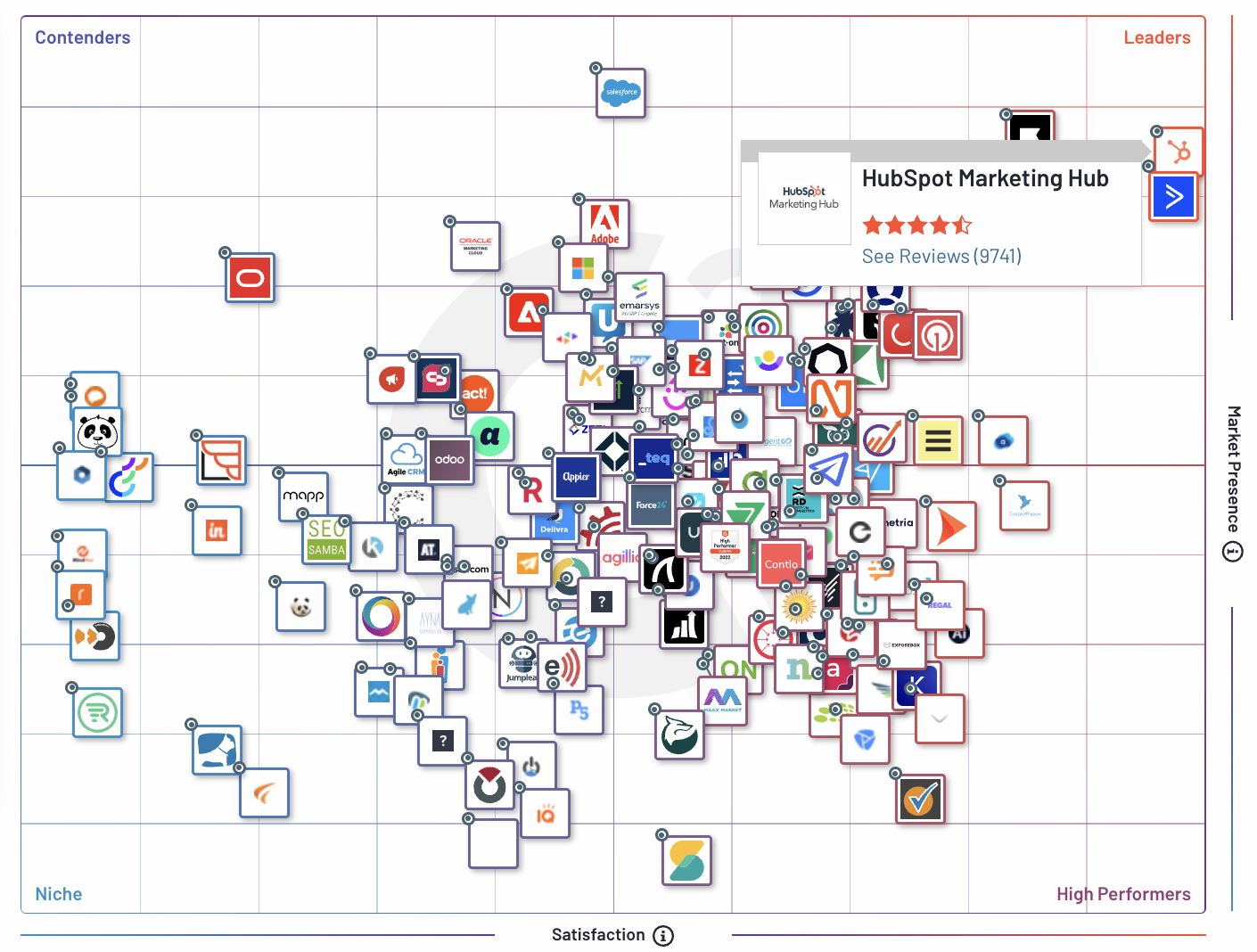
23 min
Inhoudsopgave
What is Inbound Marketing? What are the steps to start with Inbound Marketing? Why should you start with it, and what technology do you need for this?
What is Inbound Marketing?
Looking for an effective way to make your business stand out in the crowd? Inbound marketing is your new best friend! This strategy, gaining more traction in the digital era, focuses on strengthening the relationship between your business and potential customers.
By sparking their interests and guiding them step by step, you build lasting relationships with your target audience. The result? Valuable information about your customers and the ability to approach them more precisely and personally.
Inbound vs Outbound Marketing
Outbound marketing, also known as traditional marketing, is an approach where a company actively seeks customers through various marketing channels. The goal of outbound marketing is to attract the attention of potential customers within your target audience and persuade them to purchase a product or service.
Examples of outbound marketing tactics include:
- Television and radio advertising
- Newspaper and magazine advertisements
- Direct mail (such as flyers, brochures, and catalogs)
- Telemarketing (phone calls)
- Billboards and outdoor advertising
- Cold calling and email campaigns
Inbound marketing is a marketing strategy that focuses on attracting customers by creating and sharing valuable and relevant content. Instead of actively seeking customers, inbound marketing aims to have customers come to the company. This is achieved by providing useful information, solutions, and educational materials that align with the needs and interests of the target audience.
Examples of inbound marketing tactics include:
- Content marketing (such as blog posts, white papers, and e-books)
- Search engine optimisation (SEO)
- Social media marketing
- Email marketing (such as newsletters and nurture campaigns)
- Webinars and online courses
- Videos and podcasts
The key difference between outbound and inbound marketing is the approach: outbound marketing actively approaches customers and persuades them to buy a product or service, while inbound marketing focuses on attracting customers by providing valuable content and building relationships. Learn more about the differences between Inbound & outbound marketing.
Why Choose Inbound Marketing?
Inbound marketing is the key to attracting customers in this digital era. If you're looking for a fast and efficient way to attract potential customers, inbound marketing is ideal for your business.
- More customers, lower costs.
Companies benefit significantly from inbound marketing. Compared to traditional forms of marketing, inbound marketing is much more cost-effective. This approach utilises free channels such as social media, search engine optimisation (SEO), and blogs to reach your target audience. This results in lower costs associated with lead generation. You create valuable content that can be disseminated online quickly and efficiently. - A higher ROI is within reach.
As inbound marketing focuses on potential customers already interested in your product or service, there is a higher chance of return on investment (ROI). By emphasising trust-building and strengthening relationships with your customers, inbound marketing contributes to higher customer retention. This not only attracts new customers but also retains and expands existing ones. This can lead to sustainable growth for your business and a stronger position in the market.
- The measurable magic of inbound marketing.
In traditional marketing, such as newspaper ads and TV commercials, it's often challenging to measure the impact and determine how people respond to these ads. In contrast, inbound marketing provides a comprehensive digital footprint to track. This allows you to precisely see who visits your website, which keywords are used, and what appeals to potential customers. In essence, inbound marketing is like a digital detective that helps better understand and analyse the interests of your target audience. - A lasting impression on your customer.
Long-lasting results are a hallmark of inbound marketing. By creating targeted content, such as a blog post that ranks high in search engines, your business continuously attracts interested readers. It requires regular effort, but it will lead your company to a strong and enduring presence in the market.
How does Inbound Marketing work?
But how does inbound marketing work exactly? Simply put: like a magnet. By creating and sharing targeted content through various channels, such as your website and social media, you naturally attract potential customers to your business. No intrusive ads or spam, but content that is genuinely relevant to your target audience. The result? More attention, more leads, and ultimately more satisfied customers.
Inbound marketing versus content marketing: what's the difference?
It's like identical twins. Inbound marketing and content marketing are two terms that are often used interchangeably but have slight differences. The main distinction between the two lies in the focus. Content marketing primarily focuses on creating valuable content to inform and entertain the target audience, while inbound marketing concentrates on developing a comprehensive strategy to generate leads and convert them into customers. Therefore, content marketing can be seen as a component of inbound marketing, as content plays a crucial role in the strategy to generate valuable leads.
Inbound marketing: the ultimate strategy for growth and success.
Reach your target audience quickly and efficiently by establishing a successful inbound marketing strategy. This strategy involves various steps, such as defining your goals and objectives, identifying your target audience, creating targeted content for distribution, and finally, measuring and analysing results to continually adjust and improve your marketing strategy. Build a strong connection with your potential customers, increase brand awareness, and ultimately generate more leads and effective customers by implementing a structured inbound marketing strategy.
1. Define your goals and objectives
Determine what you want to achieve with your inbound marketing efforts, such as increasing brand awareness, generating leads, boosting sales, or improving retention
2. Identify your target audience
Analyse your current customer base and conduct market research to create your ideal customer profile (buyer persona). Gain insight into your customer's problems, challenges, demographic data, interests, and purchasing behavior. This way, you can create valuable content that addresses the needs and desires of your target audience. Persuade them with targeted content to choose your brand. Reach them more effectively by researching the channels they use to seek information. Adapt the content and format of your material to meet your customer's needs.
Establishing the ideal marketing channels increases your chances of brand awareness, resulting in more leads. Create a loyal customer base and let your business grow successfully by applying these steps.
3. Create valuable content for each stage of the customer journey.
Inbound marketing consists of three phases: attract, engage, and delight

Attract
The first phase of inbound marketing is 'Attract.' Capture the attention of potential customers by creating targeted content that aligns with their interests and needs. Focus on increasing awareness and brand recognition in this step to attract more visitors to your website. Your customers are looking for interesting and valuable content that resonates with them. By sharing relevant and engaging content such as:
- blogs
- social media-content
- video's, infographic
- e-books, white papers
- podcasts
- webinars
- interactive content (quizzes)
Generate the interest of potential customers with the ultimate goal of drawing them to your business. To deliver this content to your target audience, you can use various marketing techniques such as:
- Search Engine Optimisation (SEO)
- Social Media Marketing
- Paid Advertising (Google Ads, Facebook Ads, LinkedIn Ads)
- Influencer Marketing
This approach helps you reach your target audience more quickly and effectively on the channels where they are active, searching for solutions to their problems, ways to achieve their goals, or discovering new products and services. By providing targeted and valuable content on these platforms, you gain the trust of potential customers and attract them to your business. When you engage these potential customers in the 'Attract' phase, you guide them to the next step of the Inbound Marketing process, where you engage and convert them into leads.
Engage
The second phase of inbound marketing is 'Engage.' Build a relationship with your potential customers and pique their interest in your product or service by offering them valuable information and persuading them to leave their contact details. Communicate more easily with your potential customer and guide them through the sales process. Provide targeted content that is relevant to your audience, such as:
- Case studies
- Demo videos
- Product information
- Free trials
- Personalized emails
In addition to using targeted content, it is also essential to apply ideal marketing techniques to convert potential customers into leads. The techniques you can use for this include:
- Conversion optimization
- Lead magnets
- Landing pages
- Forms
- Call-to-action buttons
- Live chat
In summary, in the 'Engage' phase of inbound marketing, the focus is on building a relationship with your potential customer and offering them valuable information that sparks interest in your products or services. By providing this valuable content, you increase the likelihood that visitors will leave their contact information, resulting in the generation of more leads.
Delight
The third and final phase of inbound marketing is 'Delight.' Naturally, the goal is to turn your customer into a lasting one. Convert your customers into loyal promoters by offering them an excellent customer experience, assisting them in solving their problems, and providing them with valuable information even after they become customers. To achieve this goal, you can use various types of content such as:
- Webinars
- Free tools
- Blog articles
- Emails with tips and advice
- Social media content
Successfully completing this step requires not only the use of targeted content but also the implementation of the right marketing techniques. Some methods you can use for this are:
- Customer service
- Email marketing
- Social media monitoring
- Interaction
- Retargeting
As a marketing manager, it is crucial to understand these three phases of inbound marketing and apply them in your marketing strategy. By using the right content and marketing techniques in each phase, you attract more visitors, generate more leads, retain customers, and turn them into loyal promoters of your company.
4. Optimise for search engines (SEO):
Ensure that your content is easily discoverable by search engines by identifying and using relevant keywords. Utilise various techniques such as keyword research tools, Google Keyword Planner, or SEMrush. Optimise your website by adjusting its structure, adding concise texts to images, and using meta-descriptions to provide a summary of your webpage's content. Craft a short but compelling description that captures the attention of potential visitors, encouraging them to click through to your website. Implement a robust link-building strategy, garnering links from reliable webpages to your site, and share content on social media to obtain more links. This will result in increased credibility, positioning your website as relevant to search engines. Executing this effectively expands your reach and attracts more potential customers.
5. Promote your content through social media
Utilize social media platforms such as TikTok, Facebook, Twitter, LinkedIn, and Instagram to share and promote your content. This helps expand your reach and attract new audiences. Share your message creatively with your target audience by using various content formats and tools available on these social media platforms.
Leverage TikTok, a valuable platform to rapidly and efficiently distribute your content. Capture your audience's attention by sharing short and creative videos or utilise the duet feature to collaborate with other users. Use Instagram for sharing content in a fun and informal manner, employing carousels or creating reels for short videos.
Apply LinkedIn to share valuable content in a business and professional manner, such as infographics and presentations or by crafting long-form posts. Finally, Twitter is an ideal app for disseminating concise messages. Use hashtags, participate in conversations, leverage trending topics, and make your tweets interesting and relevant to your potential customers.
Understand the different features on each platform and use them to tailor your content better to your audience, encouraging increased engagement and interaction with your potential consumers.
6. Implement e-mail marketing
Build an email list and regularly send newsletters with valuable content, promotions, and updates. Use email automation and segmentation to send targeted, personalised messages that align with the interests of your subscribers.
7. Analyse and measure the results:
Utilise analytics tools like Google Analytics to measure the performance of your inbound marketing strategy. This helps gain insights into what works and what doesn't, identifying areas for improvement. Activate HubSpot analytics to automatically track visitor behavior on your website. HubSpot stores information on who your visitors are, how long they stay on your website, and their actions, such as downloading whitepapers or filling out a form. Set up targeted marketing campaigns and gain deeper insights into the needs and interests of your target audience by leveraging the many features and benefits offered by HubSpot analytics.
8. Optimise and continually improve:
Based on the data collected, continually refine and enhance your strategy. This includes testing different content formats, adjusting your social media approach, and fine-tuning your email marketing campaigns.
By following these steps, you can develop an effective inbound marketing strategy focused on attracting the right audience, building lasting relationships, and driving growth.
The secret to success lies in the right software
Managing good software is essential for inbound marketing, given its digital nature. The right program plays a significant role in managing, automating, and measuring various aspects relevant to an inbound marketing strategy. Suitable software enables you to create and distribute targeted content across various channels. Moreover, software aids in automating personalised emails to customers with the aim of completing the purchasing process. Therefore, it can be established that good software is crucial for inbound marketing as it helps your business execute the strategy efficiently, measure its results, and ultimately improve.
HubSpot is an all-in-one tool for online success, offering a comprehensive set of features specifically designed to optimize inbound marketing. By utilising HubSpot's software, it enhances inbound marketing processes, ultimately leading to more growth and success. HubSpot's software includes CRM, Marketing Hub, Sales Hub, HubSpot CMS, and Service Hub, all tools deployed during the execution of inbound marketing.
G2: Marketing Hub: Discover where HubSpot Marketing Hub stands in the G2 ranking
HubSpot at the top of the G2-score
Are you looking for the ideal software that best suits your business? I have good news! Research has shown that HubSpot users highly recommend the software. With an impressive G2 score of almost five stars and thousands of positive reviews, HubSpot clearly stands out from the competition. This high G2 score provides a compelling indication of HubSpot's popularity and appreciation among customers.

To make the right choice for your business, it's essential not only to consider the costs but also to look at the experiences of other users. This provides a better insight into how well the software aligns with your specific needs and how it will perform in practice. This gives you a clear picture of the software's value and how well it meets your requirements.
With strong recommendations from HubSpot users and a high G2 score, it's evident that the software is a valuable investment for your business. Using HubSpot, you can take advantage of its many benefits, including a well-designed program with proven value and numerous user recommendations in your industry.
In summary, HubSpot is a powerful and effective solution to help your business grow and achieve your specific goals.

Stay informed
Subscribe to our newsletter
also interesting


